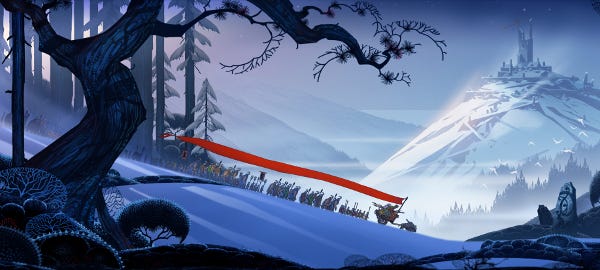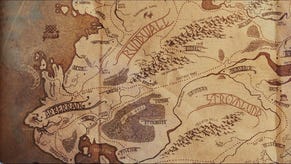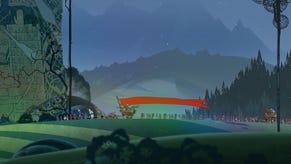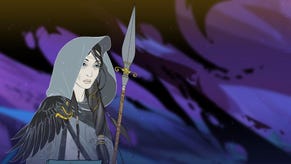Impressions: The Banner Saga's F2P Multiplayer
The Banner Saga Blowout, Pt 1
I recently ventured to the definitely-not-cold, completely-un-northern reaches of sunny Austin, Texas, where Stoic welcomed me into its Kickstarter-funded Viking castle with open arms. OK, it was more of a paper-walled one-room office, but still. More importantly, the four-man squad of former BioWarians spent hours showing and telling me every last detail about their upcoming hand-drawn turn-based epic, The Banner Saga. So, in an attempt to make this digestible, I've broken it up into parts. First up, The Banner Saga: Factions, a free-to-play multiplayer spin-off set to launch in November. Inside, you'll find my hands-on impressions. Next week, we'll be posting interviews that cover everything else: how Stoic plans to handle microtransactions, the developer's philosophy toward class balance, how matchmaking will work, gobs of details on the single-player campaign, and tons more. For now, though, here's what it's like to actually play the game.
"Let's let him win," art director Arnie Jorgensen said with a smirk. In that moment, his comment sort of riled me up. I mean, for one, I wanted the real Banner Saga: Factions experience - not a dumbed-down, edge-rounding journo-friendly edition. And also, I love these sorts of games. I spent more than 200 hours with Final Fantasy Tactics as a young aspiring world-conqueror. In other words, my skills as a turn-based tactician are not to be trifled with. But then the battle began, and I saw multiple health stats, positioning bonuses, class-specific passive abilities, countless stats, and and and...
Well, I guess I was sort of glad they let me win that first match.
On first approach, The Banner Saga felt just like any other turn-based strategy RPG. I positioned my four units on the snow-engulfed battlefield, arranged them in a traditional "melee business in the front, squishy party in the back" formation, and indicated that I was good to go. But then I made my first moves, and things got hairy. Flowing Viking giant beard locks hairy. I decided to advance my archer so as to make my opponent, technical director John Watson, think twice about charging into range with his two colossal melee brutes. Even early on, though, I had quite a few offensive options, so I decided to study up on them. And then, suddenly, my turn flat-out ended, and my archer was left totally exposed.
It was the timer. That goddamn timer. I didn't even notice the Devil's Own Timepiece until my 45 seconds had already whizzed by, and my archer was in serious trouble. At this point, many of the aforementioned attacks, abilities, and stats once again caught my eye. With an elbow. Watson's archer opened fire on mine, opting to bypass armor and leave a bolt quivering in my archer's strength stat. So here's the thing about that: Banner Saga actually treats strength and armor as intertwined health stats. Armor, of course, dictates how much damage a character will take, but strength itself is a little more complex. In short, though, losing all of it is fatal, and losing some takes big chunks out of how much damage a character can deal.
So it's a balancing act, and as long as an enemy's armor amount is higher than your strength, the most damage you can deal is one. Generally speaking, it's best to attack armor directly first, then go for the kill. But not always. See, that feeds into Banner Saga's other completely brilliant tweak to the rusted mechanical innards of this genre: willpower. Basically, every character has a small pool of it (think six or seven points, maximum) and it can be poured into special attacks, moving a couple extra spaces, or giving normal attacks a little extra oomph. Or a lot of extra oomph, actually. Once it runs dry, it's gone for the duration of the match, but it's also crucial to victory. In my experience, it's not a great idea to be stingy with the stuff.
So back to my archer, who at this point was probably cursing whatever bumbling sky deity (hint: me!) led her to this grim fate. Watson proceeded to pump three willpower (the max for any of the classes I saw) into a single attack and take aim for strength. Since willpower bypasses armor, it totaled out to four damage. Four. And since my archer didn't start out with much strength to begin with, she was effectively crippled for the rest of the match. Watson, meanwhile, was pretty pleased with himself, as a full-strength archer's "puncture" passive ability - which boosts damage in direct proportion to how much armor their opponent's lost - becomes a total nightmare late game.
Upping the stakes further, Banner Saga doesn't actually have healing spells or items. My archer, then, was pretty much doomed to limply toss foil-tipped toothpicks at her heavily armored foes for the rest of the match. It might sound a bit annoying - and at the time, it was - but Banner Saga's timer and the inability to reverse damage colluded to lend an incredible sense of permanence to each turn. Put simply, every decision absolutely counts, and the clock's counting down rapidly while you're making it. One wrong move, and you might have just thrown away your Queen on some pitiful Pawn. It's a total thrill - which is something I'm not sure I've ever said about turn-based strategy RPGs.
That chess comparison, though, is actually more apt than you might think. Stoic playtests new unit ideas on a real-life chess board, and the Sport of Kings' influence shows in another pillar of Banner Saga's design: positioning and formation. "We're trying to encourage something more like chess than Final Fantasy Tactics," explained creative director Alex Thomas. "Positioning is really important."
He then proceeded to help me ("I DON'T NEED HELP GOSH... but thanks") manipulate Watson's archer into a doom scenario of her own. So I advanced my Provoker - a heavy-hitting horned giant of a thing - to a position next to her and used his signature ability: taunt. As a result, she'd automatically attack my Provoker next turn. Problem is, archers can't attack adjacent squares. They are, after all, a ranged class. So that's one completely useless, totally immobilized archer, coming right up. And after that, well, let's just say the Provoker's giant pointy stick wasn't just for show.
That's just the tip of the iceberg fortress lair, too. Most passive abilities are based entirely around positioning, so going all willy-nilly lone wolf probably isn't in your best interest. For instance, at one point I maneuvered my semi-squishy axeman right into Watson's mountain-like first line of defense, but had him flanked by two units with the "shield wall" passive. This boosted his defense to hilarious heights, resulting in a terrifying axe murderer demon of both offense and defense.
Positioning is equally key in the use of active abilities - not to mention wonderfully satisfying when done correctly. At one point, I managed to trap Watson's axeman against two of his own allies. The only direction he could move was forward. Then I fired off my archer's special ability - an arrow that'd only come down when someone stepped on a certain tile. Essentially, it's a landmine, and I don't actually think you're allowed to use it without cackling deviously and smiling in a Grinch-like fashion afterward. However, your opponent can only see that you fired it - not where - so it's a trap. Watson, then, was forced to decide whether he wanted to risk moving forward or waste a turn re-positioning his units to let his axeman go around the tile in question. I would describe my celebratory performance of "Another One Bites The Dust" afterward as tasteful yet rich with meaning.
Meanwhile, the Stoic folks regaled me with tales of even more advanced tactics - for example, using the Warleader class' (sadly not in the demo I played) ally-moving prowess to essentially give slow, heavy units double the number of turns, quickly boosting them into your opponent's squishy party zone. So yes, if it wasn't already clear, the potential for nuanced tactics and class synergy between the 16 or so options Factions is set to launch with is enormous. And I was actually playing a slightly simplified demo, so regular matches are six-on-six, not four-on-four.
"Our goal with every class was to have a few different ways that you can synergize with the rest of your team," explained Thomas. "Unlike, we feel, a lot of turn-based strategy games, nobody exists in a void of 'this guy does this one thing and then you whittle down the other guy.' Every class's abilities are intentionally designed to work with each other. Going back to that Magic: The Gathering idea, you're building a party like you're building a deck."
That said, I did have a few quibbles - mainly stemming from a clearly work-in-progress interface. Ordering anyone to do anything took multiple clicks and further "are you sure?" confirmation clicks - but when time is ticking down, every second counts. At one point, I actually lost a unit because my final click was one milisecond too late. That was exceedingly frustrating. On top of that, selecting special skills felt similarly clunky, forcing me to click on the space around a character instead of the character itself, then choose a skill, then pick a target and finally, mercifully hit something - when, in fact, simply targeting someone and picking whether I wanted to use a normal or special attack would've made a lot more sense. But Stoic showed me images of the new interface ideas it's currently tweaking, and they seem much, much, much, much better.
I must admit to initially being worried that Banner Saga - with its silky smooth Disney-style visuals making raucously passionate love to my eyeballs - was just a pretty face. Playing it, though, pretty much obliterated that fear. If Stoic can maintain this standard of quality, it could have something really special on its hands - a mixture of ocean-like tactical depth and frantic mid-match pacing that feels impressively different. I've got high hopes, anyway, and November's right around the corner. Winter is coming. But, you know, hopefully in a good way.
Check back next week for a massive two-part interview about all things Banner Saga: single-player, multiplayer, balancing concerns, microtransactions, DLC, interaction between SP and MP, etc.




















